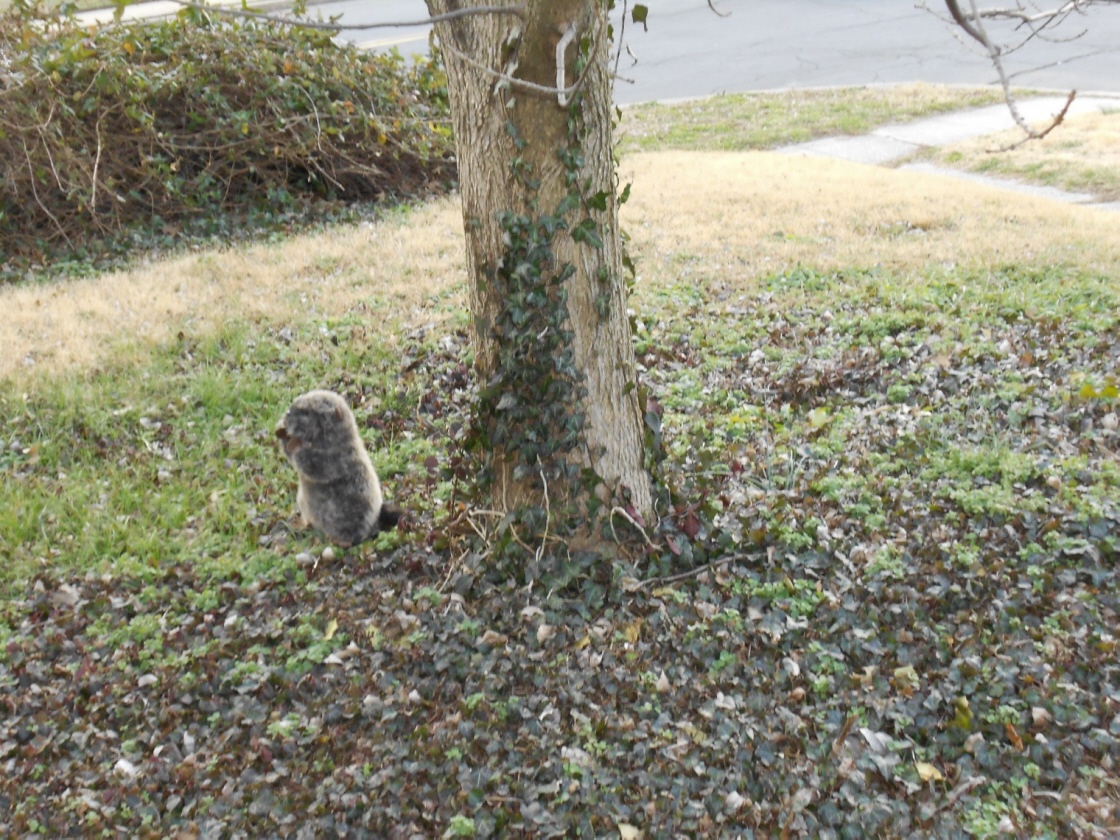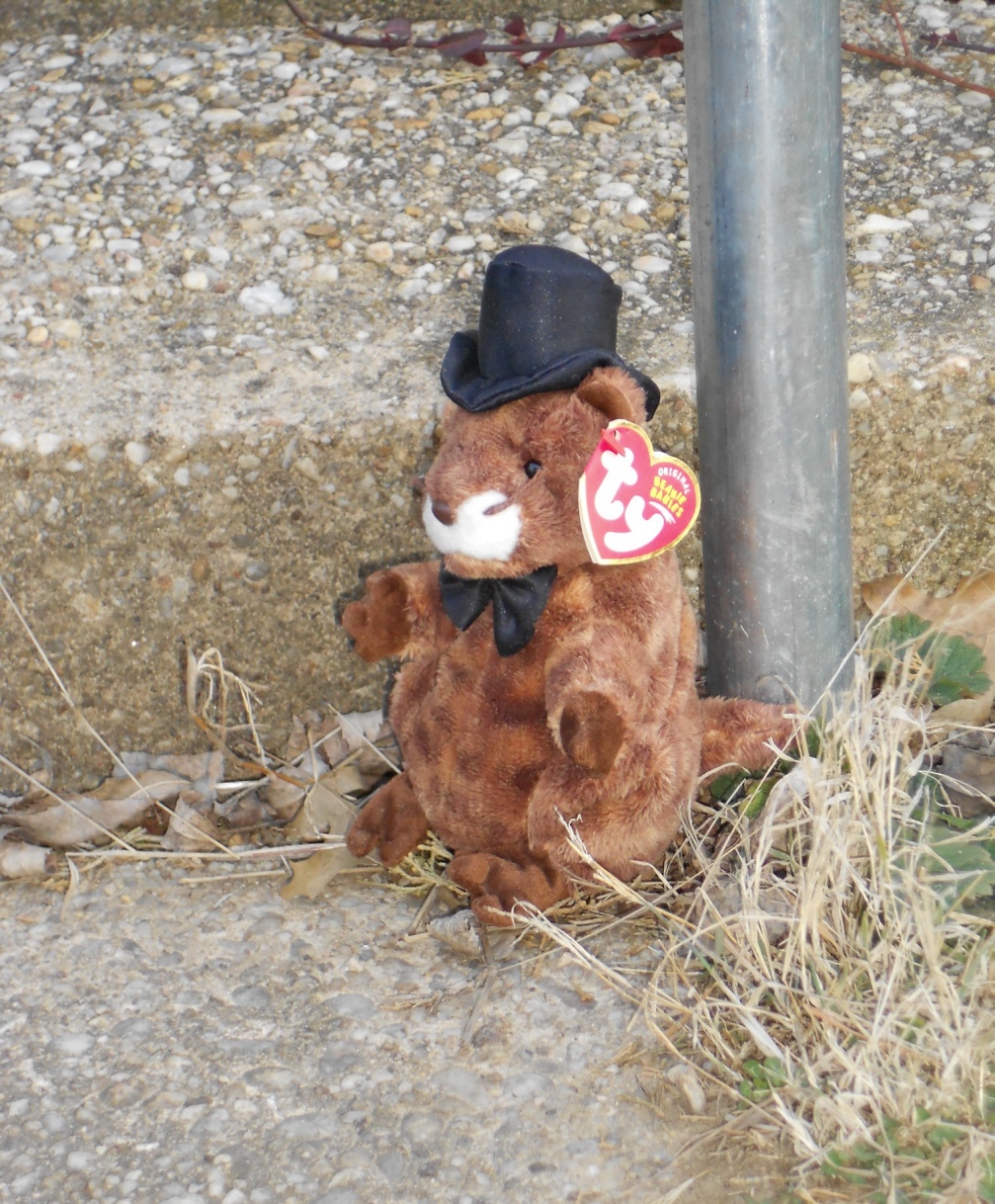
copyright February 2, 2012 Myth Woodling

copyright February 2, 2012 Myth Woodling
|
If Groundhog's Day is fair and bright, For six more weeks, Jack Frost sits tight. Should the Groundhog find it cold and drear, In just six quick weeks, Spring will be here! |
Punxsutawney Phil in Punxsutawney, Pennsylvania, USA, is one of the most famous
weather prognosticating groundhogs. But what does a groundhog have to do with
Imbolc, Candlemas, or Brigid's Day?
The earliest written reference to this American celebration was in the February 4, 1841 diary entry of James Morris, a store
owner in Morgantown, Berks County, Pennsylvania, which is preserved at the Pennsylvania Dutch Folklore Center at
Franklin and Marshall College:
Many German proverbs relate to weather forecasts involving animals, especially the European Badger, "Dachs," and the
Bear, "Bär":
Wenn der Bär auf Lichtmess seinen Schatten sieht, kriecht er wieder auf vierzig Tage in die Höhle.
Wenn die Februarsonne den Dachs nicht weckt, schläft er im April noch fest."
Wenn der Dachs zu Maria Lichtmess, mittags zwischen 11 und 12 Uhr seinen Schatten sieht, so muss er noch vier
Wochen in seinem Baue bleiben.
A modern rhyme refers to the Groundhog as an animal used in weather prognostication:
At some CPC Imbolc family events, I (Myth Woodling) have brought my Groundhog puppet inside a large brown paper bag.
The children have to coax the hibernating Groundhog to crawl out of the paper bag in which he is "sleeping" by calling,
"Wake up Groundhog!" If they aren't loud enough, he doesn't wake up. If they are too loud, he might get scared and duck
back down to hide. This "game" is a lot fun.
Groundhogs hibernate beginning in late October/early November, finally emerging from their dens around
mid-February/early March. Groundhogs prefer to live along forest edges where timbered areas are bordered by open fields.
When hibernating, the body temperature of a groundhog drops to 38 degrees. The animal's metabolism slows down and the
heartbeat decreses to about 4 bpm (beats per minute). Awake and active groundhogs have heartbeats of 80 bpm and and
body temperature of 98 degrees.
Groundhogs are common throughout Maryland. They can be found throughout the Eastern USA, down into Georga and up
into Canada. Their body is covered with grizzled, grayish brown fur down its back. Groundhogs also have a short, bushy tail
as well as strong, short legs with dark brown feet. They often sit on their haunches to feed.
These large rodents are herbivores and often graze on leaves, flowers, clover, dandelion greens, berries, and grasses,
including alfalfa, wheat, and rye. They are sometimes temped by gardens for fruits and vegetables, like cucumbers. Typically,
they weigh around 4 to 9 pounds but can reach about 14 pounds.
Their powerful limbs and feet equipped with curved, thick claws are well adapted to digging. These specialized claws dig
burrows (underground tunnels) for sleeping, nesting, and hibernating. Generally, these burrows have two to five entrances to
help avoid predators. Sometimes these burrows can be buried up to 5 feet down and can consist of as much as 45 feet of
tunnel segments. These burrows also provide homes for other animals like rabbits, opossums, skunks, and foxes.
Groundhogs often build a separate "winter burrow" for hibernating, which is dug below the frost line and remains at a stable
temperature well above freezing during the winter months. In Maryland, it is unlikely for anyone to spot a groundhog in the
wild awake and out of its "winter burrow" before mid-February.
Groundhog's Day 2021 addition:
Though groundhogs, also known as woodchucks, are native to Maryland, Groundhog's Day, February 2, is not celebrated as much in Maryland as it is in Punxsutawney, Pennsylvania.
You are most likely to spy a groundhog waddling around in late February, not early February.
Still, if the weather is gray and dreary on February 2, you shouldn't be concerned, because spring will soon be here on March 21. If however, the sun is shining bright on February 2, on Groundhog's Day, be aware there are still six more weeks of winter.
Sources:
Maryland Department of Natural Resources,
Groundhog (aka Woodchuck)
(Marmota monax), accessed 1/9/13. This information is provided as a public service of the Maryland Department
of Natural Resources. Maryland Department of Natural Resources, 580 Taylor Avenue, Annapolis, MD 21401,
1-877-620-8367, www.dnr.maryland.
STORMFAX, INC.
Groundhog Day History from
Stormfax 2013,
1996-2013, accessed 1/9/13
Patti Wigington,
Groundhog Day, 2013, accessed 1/9/13
Other fun links:
Uploaded by Kodee141414,
I've Got a Day Named After Me: February Two uploaded on Feb 2, 2012. Pardon-me-Pete sings his
"Groundhog Day" song from the 1979 TV special, Jack Frost.
Jack Frost (1979)--the Rankin-Bass, stop-motion animated holiday television special in which the groundhog,
Pardon-me-Pete, recounts how and why the winter spirit, Jack Frost, once long ago became human. 48 minutes
Pamela Curtis Swallow,
Groundhog Gets a Say, 2005, Kindergarten-Grade 3

copyright February 2, 2012 Myth Woodling
Punxsutawney Phil 2004, the Beanie Babies Collection
Last Tuesday, the 2nd, was Candlemas day, the day on which, according to the Germans, the Groundhog peeps out of his
winter quarters and if he sees his shadow he pops back for another six weeks nap, but if the day be cloudy he remains out,
as the weather is to be moderate.
In England, there's an old folk tradition involving the weather on Candlemas Day, February 2.
If the weather is bright and
clear on Candlemas, then cold, snowy, and bitter weather will prevail for the remaining weeks of wintertime. On the other
hand, grey, cold, sloshy weather at the beginning of February predicts milder weather for the next few weeks and possibly
an early thaw. There is an old, traditional rhyme which has several different versions:
If Candlemas Day is bright and clear,
This German American holiday is celebrated on the same day as Candlemas, Imbolc, or
Brigid's Day. The name Imbolc means "in the belly." At Candlemas, Imbolc, and Groundhog's Day,
the ground often looks rather
barren, but under the earth the first stirrings are happening. The increase of light has begun a signal to plant and animal life
that Vernal Equinox will arrive shortly. Life quickens in the belly of the earth.
There'll be two winters in the year.
If Candlemas brings clouds or rain,
Winter goes and does not remain.
Sonnt sich der Dachs in der Lichtmess-Woche, geht auf vier Wochen er wieder zu Loche.
When the Germans immigrated to Pennsylvania, USA, there were no European badgers,"Dachs,"
(Meles meles).
Thus, the immigrants found a similar hibernating, burrowing mammal, the diurnal groundhog
(Marmota monax) also
known as the "woodchuck," "whistle pig," "marmot," "land-beaver," for use in weather
prognostication. In the Pennsylvania
"Dutch" German dialect, Groundhog's Day is known as Grundsaudaag.
Basking [sunning] the roof in light for Candlemas [Lichtmess] week, the badger is still in his hole-four weeks.
If the bear sees his shadow on Candlemas [Lichtmess], he crawls back to forty days in the cave.
When the February sun not wakes the badger, he sleeps in April fixed.
If the badger on Mary's Candlemas sees his shadow between 11 to 12 o'clock, he must still
remain four weeks in his burrows.
If Groundhog's Day is fair and bright,
Interestingly, the Scottish Carmina Gadelica, preserved folklore about another animal
emerging from its underground burrow on "the brown day of Bride."
For six more weeks, Jack Frost sits tight.
Should the Groundhog find it cold and drear,
In just six quick weeks, Spring will be here!
The serpent will come from the hole
The snake is one of the animals associated with the Celtic Goddess Bride, aka Brigid,
Brigit, Brighid, Brigantia.
On the brown day of Bride;
Though there may be three feet of snow,
On the surface of the ground.
Directors: Jules Bass, Arthur Rankin Jr.
Writer: Romeo Muller
Stars:Buddy Hackett, Robert Morse and Paul Frees